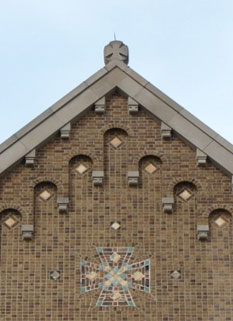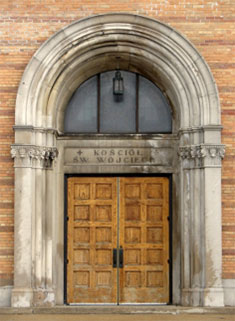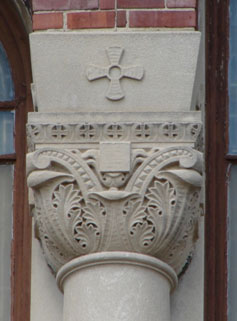Romanesque Revival
Romanesque Architecture
The Romanesque was a style of architecture common throughout Europe for two centuries, from about 1000 to 1200 AD. It was largely supplanted by the Gothic style by the end of the twelfth century. As the name suggests, the style was a continuation of many of the forms and details of earlier Roman architecture. (Like most architectural style terms, Romanesque was applied retroactively by architectural historians and was not used at the time by those who built in the style.) Although the Romanesque style was used for many types of buildings, churches and monasteries make up the largest number of surviving examples.
As in earlier Roman buildings, Romanesque architecture uses round arches for doorways, windows, arcades and vaulted ceilings. The use of round arches immediately distinguishes the Romanesque from the Gothic, of which the pointed arch is one of the defining characteristics. Romanesque churches typically have massive load-bearing walls of masonry with relatively narrow window openings.
The basilican plan, adapted from secular Roman buildings, is common to Romanesque churches. The basilican plan consists of a central nave flanked by side aisles. The nave ceiling is higher than that of the aisles, with clerestory windows in the upper portion of the nave walls. The two side aisles are separated from the nave by rows of columns that support the upper portions of the nave walls. The interior of the church thus has a strong sense of linear progression along a central axis, from the entrance at one end of the nave to the main altar at the other. (Note that the word basilica, as used by the Catholic Church, is an honorary designation and does not refer to the plan type.) Many Romanesque churches also have transepts, which are extensions along a cross-axis, perpendicular to the axis of the nave, and typically closer to the to the altar than to the nave entrance. Transepts give the building the shape of a Latin cross in plan, symbolic of the cross on which Jesus was crucified. There is usually a projecting apse at the sanctuary end of the church, appearing on the exterior in the form of either a semi-circle or half-octagon in plan. Romanesque churches across Europe, like those of the later Gothic style, were oriented with the apse at the east end, so that the congregation would be facing the Holy Land when facing the main altar of the church.
Bell towers on Romanesque churches may be square, round, or octagonal. They are most commonly seen as paired towers on the façade, flanking the entrance. Also common is a broad but generally lower tower at the crossing of the nave and transepts. Romanesque churches of northern Italy often have just a single bell tower placed on one side of the building or completely detached as a separate building. Some towers have hip roofs of relatively low pitch, while others have taller steeples. However, the elongated spires of Gothic church towers are not characteristic of the Romanesque style.
A common ornamental motif on Romanesque buildings is the row of small arches, usually projecting only a few inches from the wall, which forms a decorative band along the top of the wall at the eaves and on the gable ends. Entrance portals are another area of focus for Romanesque ornament. These commonly have a series of receding columns or pilasters, topped by a series of concentric arches of diminishing size. Column and pilaster capitals are distinctly different from those of the Doric, Ionic, and Corinthian orders of the Classical tradition. Romanesque capitals are typically cushion-shaped, transitioning from round at the bottom to square at the top. They are often richly ornamented with a wide variety of carved motifs, including foliage, animals, human figures, mythical beasts, and intricate scrollwork.
Romanesque Revival
The earliest American examples of the Romanesque Revival date to the 1840s. One of the earliest is the Smithsonian Institution building in Washington, D.C., designed by James Renwick and constructed from 1847 to 1851. This impressive building, known as the Castle, helped to popularize the style in the following decades. While the Romanesque Revival was used primarily for churches, and occasionally for synagogues, it also achieved some popularity for college and university buildings.
The revival style incorporated many of the design motifs of the original Romanesque, including corbeled arcades along the tops of the walls, ornate entrance portals, and columns with elaborately carved capitals. Wile most Romanesque churches were built of stone, many churches in the revival style are of brick and have larger windows than the Romanesque originals. The churches of the revival style therefore often lack the visual solidity of the original Romanesque churches. Mural painting is a common form of decoration on the interiors of Romanesque Revival churches, as it was in the Romanesque period.
American churches of any style do not necessarily follow the earlier custom of orienting the building so that the congregation is facing east during the service. Instead, the orientation of the church is generally determined by the size, shape, and street frontage of available urban building lots. Where an American church is oriented with the apse at the east end, it is usually a coincidence, or in some cases the result of a deliberate decision to acquire a lot with the street frontage along the west side.
An important subtype of the Romanesque Revival is the Richardsonian Romanesque, named for the Boston architect Henry Hobson Richardson, who developed his own version of the style in the 1870s and 1880s. Buildings by Richardson incorporate bold massing, unusually broad arches, and highly textured exterior walls using quarry-faced stone or a combination of stone and brick. Richardson’s buildings attempted to visually replicate the massive character of Romanesque buildings. His designs were widely published in architectural journals of the period and were highly influential, leading to a profusion of Richardsonian buildings by other architects during the last two decades of the nineteenth century. Architects used the style for a much wider variety of building types than the non-Richardsonian version of the Romanesque Revival. It was especially popular for county courthouses, libraries, and other government buildings, following Richardson’s own designs for several New England libraries and the Allegheny County Courthouse in Pittsburgh. Milwaukee’s own Federal Building on East Wisconsin Avenue is closely modeled on Richardson’s Allegheny County Courthouse. Other notable secular Milwaukee buildings in the Richardsonian Romanesque style include the former office building at 611 North Broadway, built in 1886 and now the Hilton Garden Inn, and the former Blatz Brewery Headquarters at 1120 North Broadway, built in 1890.
Romanesque Revival Churches in Milwaukee
There are 16 Romanesque Revival churches in Milwaukee. The oldest surviving church of this style in the city dates to 1876, while the most recent dates to 1942. The style was popular for Catholic churches, but far less so for Protestant denominations, and there are no synagogues in the style in Milwaukee. Of the city’s 16 Romanesque Revival churches, 13 were built for Catholic parishes.
Two of the city’s Romanesque Revival churches are Richardsonian designs: St. Paul’s Episcopal of 1883 and Grand Avenue Congregational of 1887, both designed by the Milwaukee architect Edward Townsend Mix. St. Paul’s is built of stone, and Grand Avenue Congregational combines stone and brick, while the other 14 Romanesque Revivals are of brick with only small amounts of stone trim for such items as cornices, buttress caps, and windowsills. There are many variations in the arrangement of bell towers, including central towers, side towers, paired towers, and no towers. No single arrangement predominates. The corbeled arcade of brick is common, with the exception of the two Richardsonian Romanesque churches. The basilican plan is less common, with the majority of the city’s Romanesque Revival churches having a gable roof spanning the entire width of the building rather than having a narrower roof covering only the nave and separate, lower roofs over the side aisles. The 11 buildings profiled in this section show a style that shares common characteristics but is capable of considerable variety.


